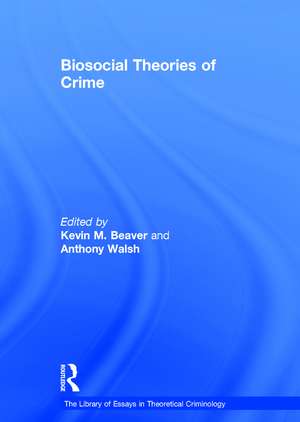Biosocial Theories of Crime: The Library of Essays in Theoretical Criminology
Autor KevinM. Beaveren Limba Engleză Hardback – 28 aug 2010
Preț: 1475.60 lei
Preț vechi: 2053.93 lei
-28% Nou
Puncte Express: 2213
Preț estimativ în valută:
282.34€ • 294.82$ • 233.16£
282.34€ • 294.82$ • 233.16£
Comandă specială
Livrare economică 25 martie-08 aprilie
Doresc să fiu notificat când acest titlu va fi disponibil:
Se trimite...
Preluare comenzi: 021 569.72.76
Specificații
ISBN-13: 9780754629191
ISBN-10: 0754629198
Pagini: 522
Dimensiuni: 169 x 244 mm
Greutate: 1.32 kg
Ediția:1
Editura: Taylor & Francis
Colecția Routledge
Seria The Library of Essays in Theoretical Criminology
Locul publicării:Oxford, United Kingdom
ISBN-10: 0754629198
Pagini: 522
Dimensiuni: 169 x 244 mm
Greutate: 1.32 kg
Ediția:1
Editura: Taylor & Francis
Colecția Routledge
Seria The Library of Essays in Theoretical Criminology
Locul publicării:Oxford, United Kingdom
Cuprins
Contents: Introduction; Part I Statements on the Biosocial Perspective: Biological perspectives in criminology, Diana H. Fishbein; Segregation and stratification: a biosocial perspective, Douglas S. Massey; Adolescence-limited and life-course-persistent anti-social behaviour: a developmental taxonomy, Terrie E. Moffitt; Behavior genetics and anomie/strain theory, Anthony Walsh; H.J. Eysenck in Fagin's kitchen: the return to biological theory in 20th-century criminology, Nicole Hahn Rafter. Part II Genetics and Crime: Behavior genetics of aggression in children: review and future directions, Lisabeth Fisher DiLalla; The new look of behavioral genetics in developmental psychopathology: gene-environment interplay in antisocial behaviors, Terrie E. Moffitt; Role of genotype in the cycle of violence in maltreated children, Avshalom Caspi, Joseph McClay, Terrie E Moffitt, Jonathan Mill, Judy Martin, Ian W. Craig, Alan Taylor and Richie Poulton; The integration of genetic propensities into social-control models of delinquency and violence among male youths, Guang Guo, Michael E. Roettger and Tianji Cai; The interaction between genetic risk and childhood sexual abuse in the prediction of adolescent violent behavior, Kevin M. Beaver; Sources of exposure to smoking and drinking friends among adolescents: a behavioral-genetic evaluation, H. Harrington Cleveland, Richard P. Wiebe and David C. Rowe. Part III Evolutionary Psychology and Crime: Gene-based evolutionary theories in criminology, Lee Ellis and Anthony Walsh; Self control, social control and evolutionary psychology: towards an integrated perspective on crime, Augustus Brannigan; A gene-based evolutionary explanation for the association between criminal involvement and number of sex partners, Kevin M. Beaver, John Paul Wright and Anthony Walsh; Women and crime: an evolutionary approach, Anne Campbell, Steven Muncer and Daniel Bibel; Why men commit crimes (and why they desist), Satoshi Kanazawa and Mary C. Still. Part IV Neuroscience and Crime: Neuroanatomical background to understanding the brain of the young psychopath, James H. Fallon; The roles of orbital frontal cortex in the modulation of antisocial behavior, R.J.R. Blair; A social neuroscience perspective on adolescent risk-taking, Laurence Steinberg; Brain abnormalities in murderers indicated by positron emission tomography, Adrian Raine, Monte Buchsbaum and Lori LaCasse; Reduced prefrontal and increased subcortical brain functioning assessed using positron emission tomography in predatory and affective murderers, Adrian Raine, J. Reid Meloy, Susan Bihrle, Jackie Stoddard, Lori LaCasse and Monte Buchsbaum; Name Index.
Notă biografică
Kevin M. Beaver is Assistant Professor, College of Criminology and Criminal Justice, Florida State University, USA and Anthony Walsh is Professor of Criminal Justice, Boise State University, USA
Descriere
Biosocial criminology is an emerging perspective that highlights the interdependence between genetic and environmental factors in the study of the causes of antisocial behaviour. This volume brings together the most influential biosocial criminological articles which examine the connection between genetics and crime, evolutionary psychology and crime, and neuroscience and crime. The volume is a valuable resource for those interested in understanding the causes of crime from a biosocial criminological perspective.











